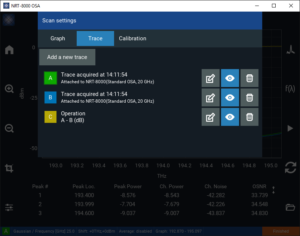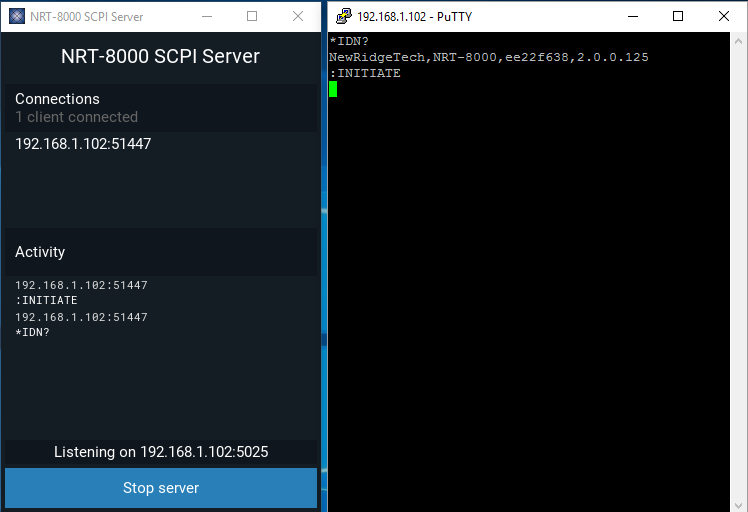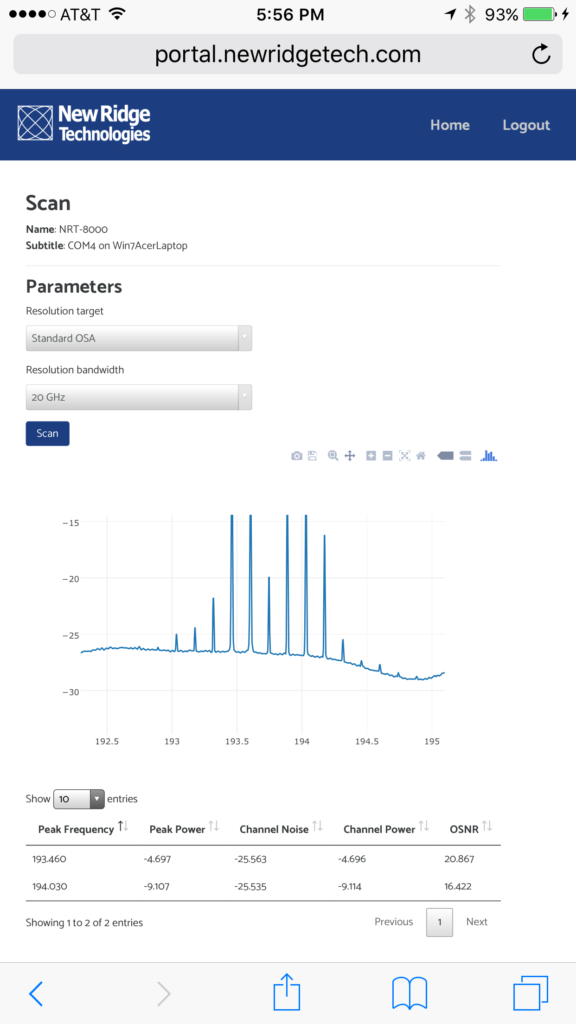With the release of software version 2.1.0, the NRT-8000 is truly a powerful instrument. Some of our updates offer features typical of other OSAs such as scan averaging and data logging. And some of our new features extend the NRT-8000’s capabilities beyond the boundaries of traditional OSAs. Below we will describe the most significant new features and updates.
Resolutions and Resolution Bandwidth
As before, the NRT-8000 still offers 5 resolutions that are comparable with standard OSAs at 4 GHz, 20 GHz, 40 GHz, 100 GHz and 200 GHz.
However, one characteristic of grating/slit based (standard) OSAs is that the line shape and therefore their resolution bandwidth slightly across the scan. The linewidth of a standard OSA will slightly change even over the 40 nm of the C-band. This change in the resolution bandwidth directly effects spectral analyses. For instance it reduces the accuracy of measuring OSNRs by inducing a tilt to the ASE spectrum. To address this inherent limitation, the NRT-8000 is the first OSA to offer Constant Resolution Bandwidth settings. The NRT-8000’s constant resolution bandwidths have a different line shape than the rectangular line shape obtained from a slit OSA. The resolution bandwidth can be set to remain constant in either frequency or wavelength domains. Any constant resolution bandwidth greater than 2.42 GHz (in the frequency domain) or 0.0194 nm (in the wavelength domain) is settable on the NRT-8000.
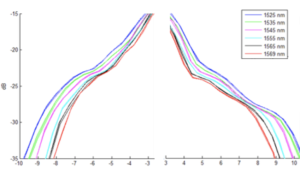
Yokagawa OSA line-widths measured at -25 dB with 4 GHz resolution. The 1525 nm width is 20% wider than at 1569 nm, when plotted as frequency (GHz).
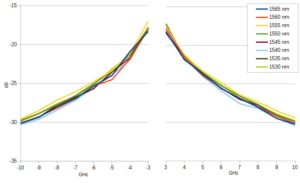
NRT-8000 OSA line-width VARIATIONS measured at -25 dB with 2.42 GHz constant Res BW resolution. There is negligible Res BW variation across the C-band.
Multiple traces
All OSAs offer multi-trace capability and the NRT-8000 is no different. Like with other OSAs you can use the multi-trace feature to compare spectral scans made at different times. For instance the first trace, A, can be measured and set as the reference, then trace B the active trace, and trace C as the calculated, normalized, difference, B – A. On the NRT-8000 you can set up as many traces as you wish (although we only offer 8 different colors). And even write your own mathematical expression to calculate relationships between the various traces.
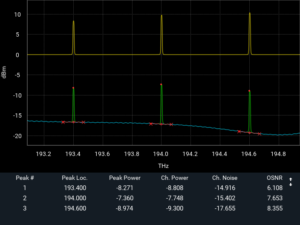
Multi-trace measurement: Trace A (Green) signal + ASE, Trace B (Blue) ASE only, Trace C (Yellow) calculated A – B.
Automated Testing – Two Ways
Many customers want to integrate the tiny NRT-8000 into their manufacturing or automated monitoring tests in their labs. The NRT-8000 offers 2 ways to automate NRT-8000 OSA testing. First is our SCPI server. The SCPI commands match those of other leading OSAs for an easy transition to the 8000 platform. The automation program (e.g. Labview) makes requests to the SCPI server to scan spectra, collect data and analyze the results. Additional functionalities will be forthcoming.
The second method available is an Ethernet interface RESTful API which allows for remote programming of the NRT-8000 through HTTP.
Internet of Test & Measurement (IoT&M)
For a while NRT has been evangelizing the integration of Internet of Things (IoT) into test and measurement services and devices. We see the future of test and measurement as a network of testing sensors accessible from anywhere. The new NRT-8000 software is our first step in making this vision a reality. NRT’s test portal can automatically find all your NRT-8000 OSAs, making them accessible from a single location.
Every OSA, anywhere, any time
Across your LAN, the NRT-8000 software employs Zero-configuration networking (zeroconf) to allow other devices running the NRT-8000 (client) software to automatically see any other NRT-8000 on the LAN. This means that from one workstation, an engineer can see, connect to, and use a NRT-8000 at the other end of the lab (or from their desk). NRT’s zeroconf LAN implementation has auto discovery so no network configuration is required.
But NRT’s IoT&M features do not stop at the edge of the LAN. The NRT cloud portal service platform allows users to share access and use NRT-8000s worldwide across the WAN. By simply entering the secure portal url, username and password, their NRT-8000 device will be shared on the cloud, no VPN required, no network configuration required, nothing. It just works! And any other authorized user will automatically see all portal-enabled 8000s when they open our application. A user can even switch between NRT-8000 devices on the fly. But more on that below.
We have created a simple web application to demonstrate the NRT-8000 and our portal access (see picture at right). You can test the simple web portal application at http://portal.newridgetech.com:10001. Enter the username: demo, and the password: demodemo to gain access to the portal and view the devices we are working with in our Maryland facility (and sometimes elsewhere).
If you prefer, a private and secure portal can be set-up for your company, to make your NRT-8000 devices accessible only for your technicians and engineers.
Multi-Trace becomes Multi-place
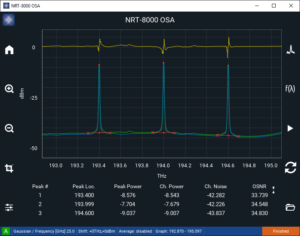
Multi-trace spectra where Trace A and Trace B are connected to different NRT-8000 units and Trace C = Trace A – Trace B.
The IoT&M features of the NRT-8000 enable measurements not available with other OSA. By integrating the IoT capabilities into the multi-trace function you can for the first time measure and compare spectra at various locations. Yes, you can assign different traces to different NRT-8000 instruments around the lab or around the world from a single computer or smart device. Then, with a single click, capture and compare the data collected from separate locations. For instance you can measure multiple OSAs in your lab. Or simultaneously measure the near end and the far end of a fiber span for easier installation or network monitoring. You can also average scans, log scans and save scans as CSV or PNG files, all from the app. No need to write a Labview program and have your network administrator connect or configure computers, routers or set up a VPN. All the necessary networking, data acquisition and data recording features are all conveniently built into the NRT-8000 app platform.
The new software is available for download here (Windows) and Google Play (Android). Calibration files matching your instrument will automatically download from the internet when you connect the device for the first time.
Stay tuned for more updates in the future.
And visit us at booth #3547 at OFC

